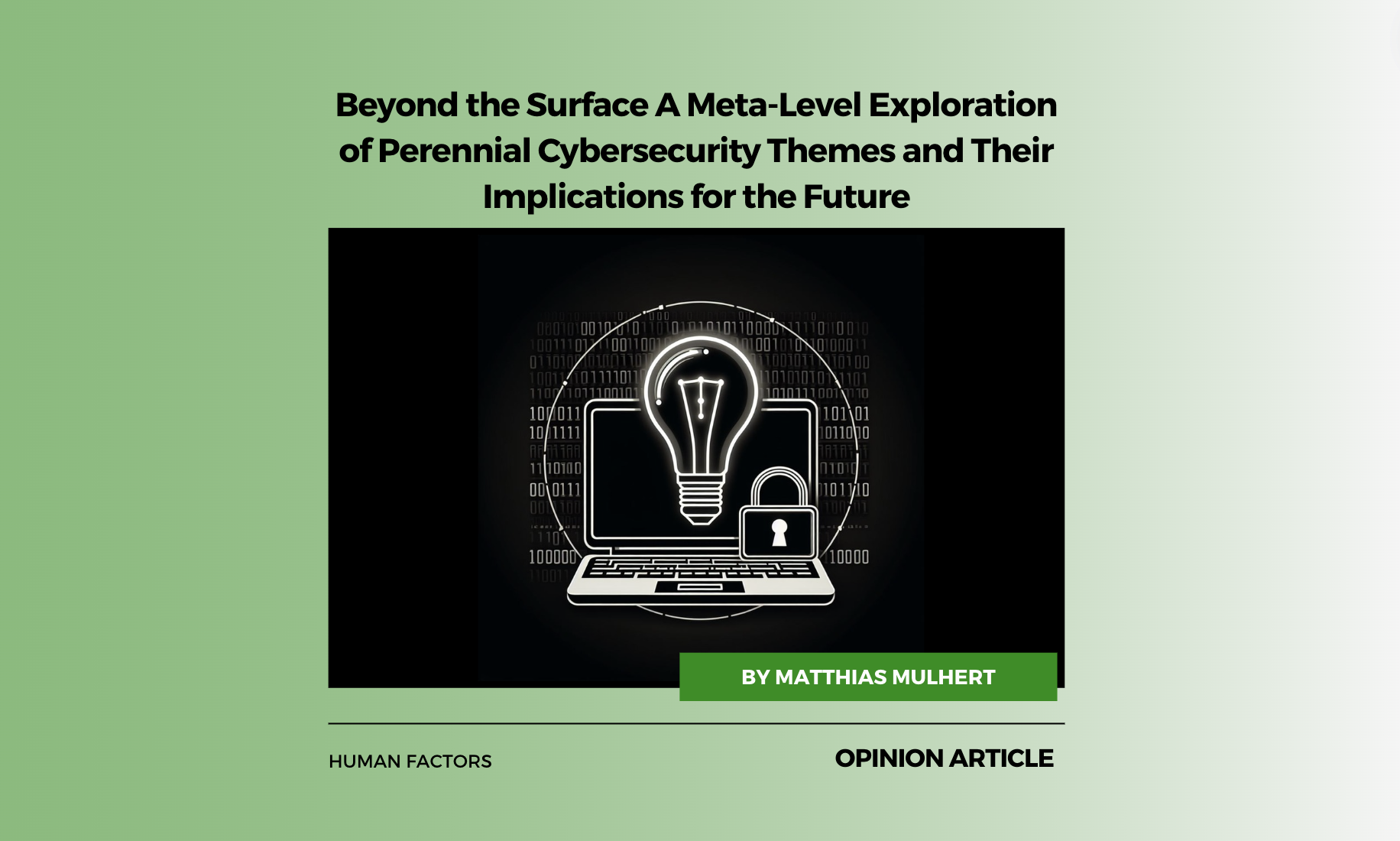Introduction
In today's interconnected world, cybersecurity is a critical concern that transcends borders and industries. Traditional analyses often focus on immediate threats and solutions, but a meta-level exploration delves deeper into the underlying principles and broader patterns that shape cybersecurity. This approach helps us understand the perennial themes that consistently influence the field, offering profound insights for developing robust and adaptive strategies.
By understanding these meta-level insights, cybersecurity professionals, policymakers, and the general public can better address the complex challenges of cybersecurity and build a more resilient digital future. The potential benefits of this approach include improved threat modeling, more effective risk management strategies, and better-informed decision-making.
1. The Cat-and-Mouse Game of Attack and Defense
Meta-Level Insight: This theme mirrors the eternal struggle between opposing forces found in nature, philosophy, and human history. In Taoist philosophy, the concepts of yin and yang represent the interconnectedness and interdependence of opposing forces. In cybersecurity, attackers and defenders are locked in a similar dance, constantly adapting and evolving in response to each other. This dynamic highlights the futility of seeking a permanent solution to cyber threats and the importance of embracing a continuous cycle of improvement and adaptation.
- Historical Parallel: The Cold War arms race between superpowers, where each side continuously developed new technologies and strategies to gain an advantage over the other.
- Example: The ongoing evolution of ransomware tactics versus the development of new defense mechanisms illustrates this constant back-and-forth battle.
- Philosophical Underpinning: The idea that balance and tension between opposing forces drive progress and evolution.
- Societal Reflection: The cybersecurity arms race reflects deeper societal tensions, such as individual freedom versus national security and economic and political competition.
2. The Human Element
Meta-Level Insight: The human element in cybersecurity reflects the broader philosophical debate about the nature of human fallibility and the limits of reason. Are we inherently flawed creatures doomed to make mistakes, or can we overcome our limitations through education, training, and awareness? This theme also touches on the psychological concept of cognitive dissonance, where individuals struggle to reconcile conflicting beliefs about security and risk.
- Motivations: Human behavior in cybersecurity is driven by universal motives such as competition, power, and financial gain. These drives have deep evolutionary roots in survival instincts and resource competition.
Example: Insider threats often arise from disgruntled employees seeking retribution or financial gain.
- Vulnerabilities: Cognitive biases (overconfidence, heuristics, anchoring) and emotional vulnerabilities (trust, fear, conformity) play significant roles in cybersecurity.
Example: Phishing scams, which prey on our trust and curiosity, exploit cognitive biases to breach even the most secure systems.
- Behavioral Economics: By understanding biases and heuristics and applying nudge theory, we can design security interventions that subtly guide users towards safer behaviors.
Example: Defaulting to strong passwords or two-factor authentication can significantly improve security without requiring users to make complex decisions.
- Diversity and Inclusion: Diverse teams enhance problem-solving and identify blind spots, highlighting the importance of diversity and inclusion in cybersecurity.
Example: The "Hack the Pentagon" program invited ethical hackers from diverse backgrounds to identify vulnerabilities in the Department of Defense systems.
- Role of Culture: Cultural attitudes towards risk, privacy, and trust significantly influence how individuals and organizations approach cybersecurity.
Example: In some cultures, the concept of "privacy" may be less important than the collective good, leading to different expectations regarding surveillance and data sharing.
- Illusion of Control: Cybersecurity often creates a false sense of security, leading individuals and organizations to underestimate risks and become complacent.
Example: Overreliance on automated security tools can result in neglecting critical manual oversight, leading to vulnerabilities.
3. The Quest for Balance
Meta-Level Insight: This theme resonates with the ancient Greek concept of the Golden Mean, which emphasizes the importance of moderation and balance in all things. In cybersecurity, the quest for balance reflects the ongoing challenge of finding a middle ground between security and usability, freedom and control, and individual rights and collective responsibility.
- Philosophical Concept: Aristotle's Golden Mean, advocating for moderation and balance as the path to virtue.
Example: Striking a balance between stringent security measures and user-friendly systems to ensure both safety and usability.
- Practical Challenge: Balancing security measures with usability and ensuring that security does not stifle innovation or productivity.
- Dichotomy of Openness vs. Security: The digital age brings a fundamental tension between the benefits of openness (innovation, collaboration, access to information) and the risks they pose to security.
Example: Open-source software offers transparency and collaboration but may also expose vulnerabilities that attackers can exploit.
4. The Escalation of Threats
Meta-Level Insight: This theme can be seen as a manifestation of the Red Queen Hypothesis, a concept from evolutionary biology that suggests species must constantly adapt and evolve to survive in a competitive environment. In the cybersecurity arms race, attackers and defenders are engaged in a similar struggle for survival, constantly pushing the boundaries of technology and innovation.
- Biological Analogy: The evolutionary arms race between predators and prey, where each adaptation by one side drives a counter-adaptation by the other.
- Historical Pattern: Technological determinism, where advancements drive societal changes and new security challenges.
Example: The rapid development of AI-driven cyber-attacks and the corresponding evolution of AI-driven defense mechanisms.
- Entropy of Cybersecurity: As systems become more complex and interconnected, the potential for chaos and vulnerability increases.
Example: The increasing complexity of IoT devices expands the attack surface, introducing new vulnerabilities.
5. The Importance of Collaboration
Meta-Level Insight: This theme aligns with the philosophical concept of collective intelligence, the idea that groups can be smarter than the sum of their parts. In cybersecurity, collaboration and information sharing can amplify the effectiveness of individual efforts, enabling a more resilient and adaptable defense against threats.
- Historical Example: The Allied code-breaking efforts during World War II, where collaboration among various countries led to significant advancements in cryptography.
- Role of NGOs: Non-governmental organizations play a crucial role in raising awareness, advocating for policy changes, and providing technical assistance.
Example: The Global Forum on Cyber Expertise (GFCE) promotes international collaboration to build cybersecurity capacity.
- Cyber Frontier: Cyberspace can be seen as a new frontier for human exploration and expansion, bringing unique challenges and opportunities for collaboration and conflict.
Example: International efforts to regulate cyberspace and establish norms for state behavior in the digital realm.
6. The Paradox of Security
Meta-Level Insight: This theme echoes the paradoxical nature of security in many aspects of life. For example, a fortress may provide physical security but can also isolate and imprison its inhabitants. In cybersecurity, overly restrictive measures can stifle innovation and create new vulnerabilities.
- Philosophical Insight: The concept of "security theatre," where measures are designed to provide a sense of security rather than actual protection.
- Historical Parallel: The Maginot Line in France, a heavily fortified defense that ultimately failed to prevent invasion during World War II.
Example: Security measures that focus on compliance rather than actual risk mitigation can create a false sense of security.
- Practical Consideration: Increased security measures can sometimes lead to increased vulnerability due to complexity and misconfigurations.
- Risk Homeostasis: People adjust their behavior in response to perceived changes in risk, which can undermine the effectiveness of security measures.
Example: Users becoming complacent when they believe security tools provide complete protection.
7. The Weaponization of Information
Meta-Level Insight: This theme raises profound questions about the nature of information and its power to shape beliefs, opinions, and actions. It also highlights the ethical responsibility of those who control information and the need for critical thinking and media literacy in the digital age.
- Historical Example: Propaganda efforts during wartime, where information was used to influence public opinion and morale.
- Ethical Responsibility: The ethics of information warfare and the responsibility to use information truthfully and constructively.
Example: Disinformation campaigns on social media platforms aimed at manipulating public opinion.
- Trust Evolution: Trust is a fundamental building block of any society, and it plays a crucial role in cybersecurity.
Example: The development of blockchain technology to enhance trust in digital transactions and reduce fraud.
8. The Digital Divide and Cybersecurity Inequality
Meta-Level Insight: This theme reflects broader societal concerns about inequality and social justice. It raises questions about the ethical implications of unequal access to cybersecurity resources and the responsibility of governments and the private sector to bridge the digital divide.
- Social Justice Perspective: Ensuring that all individuals and communities have access to the tools and knowledge necessary to protect themselves online.
Example: Initiatives to provide cybersecurity education and resources to underserved communities.
- Ethical Consideration: Addressing disparities in cybersecurity capabilities and resources.
- Power of Incentives: Incentives play a crucial role in shaping behavior in cybersecurity. Understanding these incentives can help design more effective security strategies that align with stakeholder interests.
Example: Financial rewards for ethical hackers who identify and report vulnerabilities.
9. The Psychology of Cybercrime
Meta-Level Insight: This theme delves into the darker aspects of human psychology, such as the motivations behind criminal behavior. It also raises questions about the effectiveness of traditional deterrence methods and the need for a more nuanced understanding of cybercriminals' mindsets.
- Psychological Insight: Understanding the factors that drive individuals to engage in cybercrime, such as financial gain, thrill-seeking, or social influence.
Example: The role of dark web marketplaces in facilitating cybercrime and providing anonymity to criminals.
- Philosophical Question: The nature of criminality and whether it can be effectively deterred through punishment or requires deeper societal changes.
- Illusion of Control: Cybersecurity often creates a false sense of security, leading individuals and organizations to underestimate risks and become complacent.
Example: Organizations that have not experienced a major security incident may become complacent, failing to invest in necessary security measures.
10. The Future of Cybersecurity in a Post-Quantum World
Meta-Level Insight: This theme invites us to contemplate the potential for disruptive technological change and its impact on society. It also raises ethical questions about the responsible development and use of powerful technologies like quantum computing.
- Technological Impact: The potential for quantum computing to render current encryption methods obsolete and the need for quantum-resistant cryptographic solutions.
Example: The development of post-quantum cryptographic algorithms to safeguard data against future quantum attacks.
- Ethical Consideration: The responsibility to develop and deploy quantum technologies in ways that enhance security without exacerbating inequalities or creating new risks.
- Role of Uncertainty: Uncertainty is inherent in cybersecurity, influencing behaviors and strategies. Encouraging adaptive responses to emerging threats is essential.
Example: Scenario planning and risk assessments to prepare for potential quantum computing threats.
Conclusion
Understanding perennial cybersecurity themes at a meta-level reveals deeper insights into human behavior, societal structures, and technological impacts. By integrating these insights into holistic and adaptive strategies, we can build a more secure and resilient digital future. Embracing interdisciplinary approaches, fostering collaboration, and promoting a culture of shared responsibility are essential for addressing the complex and evolving landscape of cybersecurity.
Future Trends and Challenges:
- Emerging Technologies: AI, IoT, and quantum computing will require an ecosystem approach to address their unique security challenges.
- Global Collaboration: Enhanced international cooperation is necessary to secure the global cybersecurity ecosystem.
- Human-Centric Security: Prioritizing the needs and experiences of users within the ecosystem.
- Ongoing Research and Education: Continuously evolving the cybersecurity ecosystem through research and education to keep pace with emerging threats.
Call to Action
To leverage the concept of security as an ecosystem, cybersecurity professionals and policymakers should:
- Promote Integrated Defenses: Encourage the development and deployment of interconnected and adaptive security solutions.
- Foster Collaboration: Build and support cybersecurity communities that promote information sharing and collective defense.
- Embrace Diversity: Implement diverse security tools and approaches to enhance resilience.
- Cultivate a Holistic Mindset: Adopt a holistic view of cybersecurity that considers the interactions and interdependencies within the ecosystem.



Comments
Do you want to leave a comment?
Login or register to proceed
Login Register